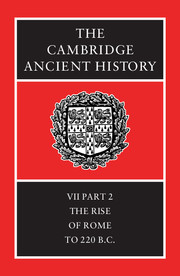Book contents
- Frontmatter
- 1 The Sources for Early Roman History
- 2 Archaic Rome Between Latium and Etruria
- 3 The origins of Rome
- 4 Rome in the fifth century I: the social and economic framework
- 5 Rome in the fifth century II: the citizen community
- 6 Rome and Latium to 390 B.C.
- 7 The recovery of Rome
- 8 The conquest of Italy
- 9 Rome and Italy in the early third century
- 10 Pyrrhus
- 11 Carthage and Rome
- 12 Religion in Republican Rome
- Appendix
- Chronological Table
- BIBLIOGRAPHY
- Index
- Fig. 50:The city of Rome in the early third century b.c.
- Map 11: The western Mediterranean in the third century
- References
9 - Rome and Italy in the early third century
Published online by Cambridge University Press: 28 March 2008
- Frontmatter
- 1 The Sources for Early Roman History
- 2 Archaic Rome Between Latium and Etruria
- 3 The origins of Rome
- 4 Rome in the fifth century I: the social and economic framework
- 5 Rome in the fifth century II: the citizen community
- 6 Rome and Latium to 390 B.C.
- 7 The recovery of Rome
- 8 The conquest of Italy
- 9 Rome and Italy in the early third century
- 10 Pyrrhus
- 11 Carthage and Rome
- 12 Religion in Republican Rome
- Appendix
- Chronological Table
- BIBLIOGRAPHY
- Index
- Fig. 50:The city of Rome in the early third century b.c.
- Map 11: The western Mediterranean in the third century
- References
Summary
THE ROMAN COMMONWEALTH
By the year 280 B.C., when Pyrrhus of Epirus first set foot in Italy, Rome had already established control, direct or indirect, over a broad band of the Italian peninsula extending from coast to coast and lying along its length for a distance in excess of 240 km. (Maps 6–7). The ager Romanus alone, the territory which was in the dominium of the Roman state, had swollen eightfold in the space of just sixty years from a mere 2000 to approximately 16,000 km. (cf. also Fig. 47 (p. 382)). From the central zone which incorporated the original urban tribes and those established on Veientan territory it radiated in three distinct spurs. One of these, by far the longest, embraced virtually the entire coastal belt from the Tiber to the township of Cumae in the south-east corner of the Campanian plain. Much of it was occupied by citizens with full voting rights – the inhabitants of the enfranchised Latin states of Lanuvium, Aricia, and Lavinium, and Roman settlers who were incorporated into the six new tribes which had been formed both along the line of the Via Appia northwest of Tarracina and in the fertile lower reaches of the Liris and Volturnus rivers. With the exception of the old Latin settlements at Ardea and Circeii and the very small maritime colonies at Antium, Tarracina, Minturnae, and Sinuessa, the remainder of this strip, comprising principally Velitrae, Privernum, Fundi, Formiae, and the Campanian townships, was occupied by cives sine suffragio. A second spur of ager Romanus extended from Rome in a more easterly direction and was separated from the coastal strip for most of its length by a succession of Latin colonies and allied townships.
Keywords
- Type
- Chapter
- Information
- The Cambridge Ancient History , pp. 420 - 455Publisher: Cambridge University PressPrint publication year: 1990
References
- 2
- Cited by



